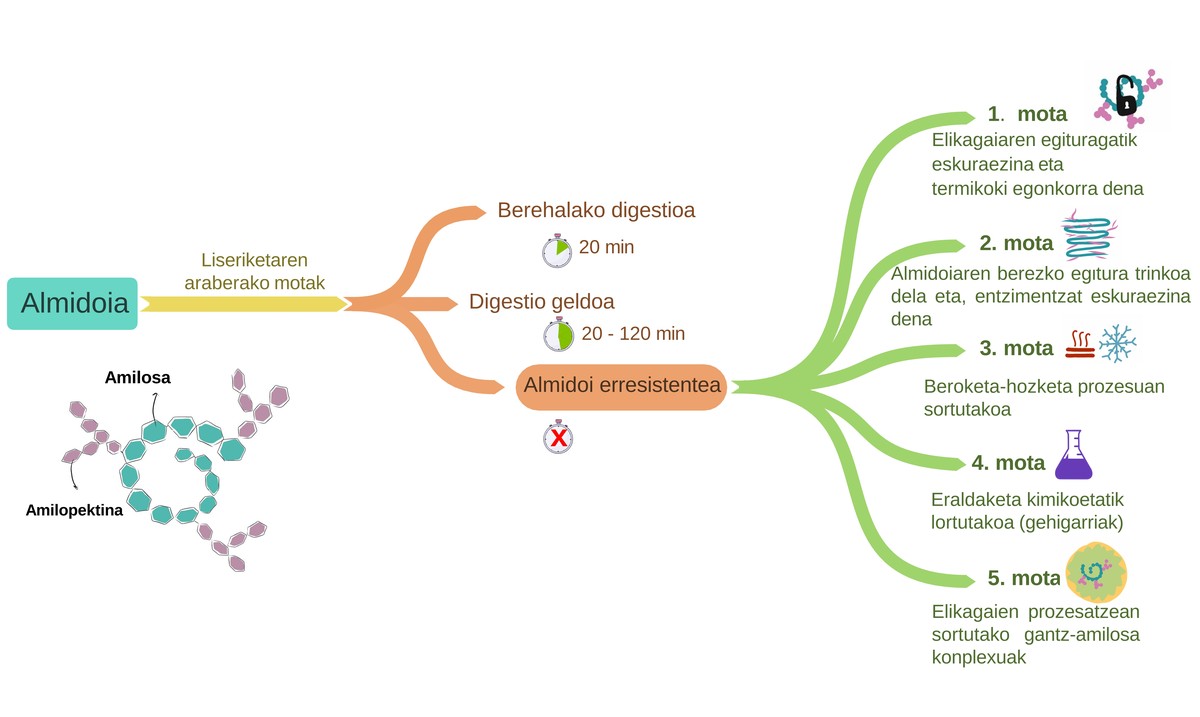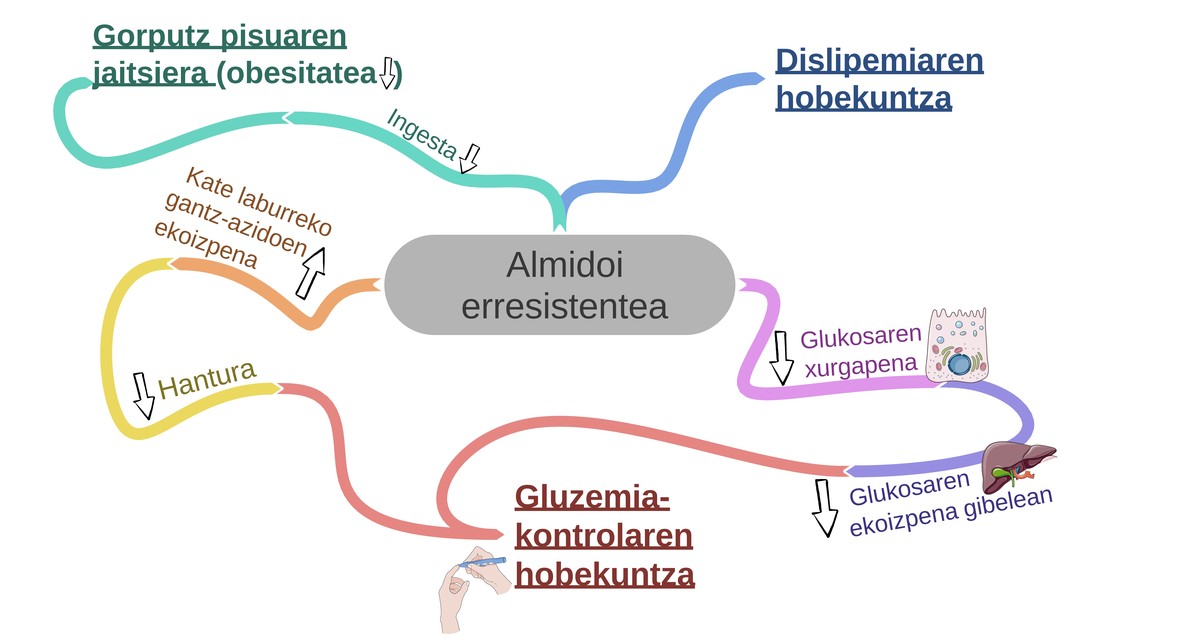Indigent but beneficial starch
Nutrizioa eta Obesitatea taldea, EHU. Elikagaien Zientzien Ikerketa Institutua (CIAL), CSIC- UAM.
Nutrizioa eta Obesitatea taldea, EHU. CIBERobn, Carlos III Osasun Institutua. BIOARABA Osasunaren Ikerketa Zentroa
Nutrizioa eta Obesitatea taldea, EHU. CIBERobn, Carlos III Osasun Institutua. BIOARABA Osasunaren Ikerketa Zentroa
What is the difference between common starch and resistant starch? Can resistant starch benefit from health? Resistant starch has received great attention in recent times and is not surprising, since several studies have shown that it can be considered an interesting instrument for the treatment and/or prevention of obesity and its comorbidities.
Starch is a complex source of carbohydrates made up of many glucose molecules. These molecules are made up of two types of chains: amylose and amylopectin. These in turn form a large network in which amylose would be the linear part and branched amylopectin. Due to the complexity of this macromolecule, these carbohydrates cannot be absorbed until they are released from the network forming the glucose units.
Although all starches have the same structure (amylopectin) and are composed of the same compounds (glucose), not all have the same behavior. Starches can be differentiated according to the degree of digestion they support. Several factors determine the digestive level, such as the amylose/amylopectin ratio, the molecular size and the origin of the starch. Therefore, they can be classified into three types (Figure 1):
- Fast starch: digestive for the first 20 minutes.
- Slow starch: It requires a digestion of 20-120 minutes.
- Resistant starch (EA): not digestible or absorbable in the human gut.
In particular, resistant starch is called because digestive enzymes cannot digest. Resistant starch can bring great benefits to the body, among them, that by not being absorbed undergoes the fermentation of the intestinal microbe by maturing the large intestine and acts as a fiber in our intestine.
There are five types of resistant starches according to their nature and the nature of the food [1] (Figure 1):
- Type 1 (AE 1): Starch that is physically inaccessible, as it is surrounded by an indestructible matrix that provides stability to cooking heat. It is mainly found in grains and legumes.
- Type 2 (AE2): given its dense structure, the action of digestive enzymes is limited. It is found in raw foods like potatoes and green bananas.
- Class 3 (AE3): Retracted starch (retrograde starch) produced in the cooling process of heated starch. For example, cooking after cooking rice or pasta and keeping it cold.
- Type 4 (AE4): Chemically modified starch used as additive for technological and sensory improvement of the food.
- Type 5 (AE 5): Complexes formed by lipid interaction, starch and alcohols. For example, those produced in the fermentation of bread.
Beneficial effects of resistant starch
The potential beneficial effects of resistant starch include its effects on obesity and its comorbidities (Figure 2). Ingestion of resistant starch, especially type SU 2, can reduce appetite [2], thereby decreasing food intake. However, only this strategy seems insufficient to treat and/or prevent obesity. Most research finds no relationship between eating resistant starch and reducing body weight or improving composition in the short term. It can help reduce body fat in the long term [3].
People with obesity often have dyslipidemia, that is, high levels of blood lipids, except for HDL-C, which is often reduced. In this sense, human research is not entirely conclusive. Studies show that resistant starch does not improve the profile of blood lipids, while other studies indicate that it may reduce cholesterol and triglyceride concentrations [3,4].
Another disorder closely related to obesity is insulin resistance, which over time can lead to the development of type 2 diabetes mellitus. In insulin-resistant individuals, blood glucose control and insulin sensitivity are two important factors to consider. Many studies show that the consumption of EC decreases the blood glucose concentration both in fasting and after eating. From these results, it can be deduced that the intake of EC, especially EC 2, has beneficial effects on glycemic control. However, these effects do not always occur [5]. The positive effects of EC 2 can be of two types. On the one hand, by not digesting the starch, the glucose that forms it will not be released and, therefore, will not be absorbed. This will prevent increased blood glucose. On the other hand, undigested starch will reach the large intestine, where it will ferment the microbiota of the colon, forming short chain fatty acids. These fatty acids may reduce hepatic glucose synthesis, which in turn may cause a decrease in blood levels.
Regarding the effect of resistant starch on insulin, not all investigations are in agreement. Some studies indicate that resistant starch improves insulin runoff and increases insulin sensitivity. As with glucose, these effects may be due to short chain fatty acids. Another possible explanation is that the effects mentioned are caused by the decrease in systemic inflammation, as resistant starch favors the growth of beneficial intestinal bacteria, in addition to improving the integrity of the eastern wall [6].
Obesity and its comorbidity produce a low level chronic and systemic inflammatory development that, in turn, worsens with the aforementioned pathologies. Therefore, the reduction of inflammatory markers can have important benefits in these people. However, the role of resistant starch on inflammation is not very clear. According to studies with EE 2, there does not appear to be a decrease in mediators in inflammatory processes [7]. In contrast, other studies have shown that resistant starch has anti-inflammatory effects as it has been linked to the reduction of markers responsible for inflammation [8].
How to eat more resistant starch or increase the amount in food
Some studies suggest that it may be beneficial to increase the consumption of resistant starch in some people. One of the simplest forms is the consumption of foods naturally containing resistant starch, such as grains, legumes, whole grains and their derivatives (whole pasta) or green banana. As previously mentioned, both EC 1 and EC 2 can be found in these foods.
Another way to increase consumption is to increase the amount of resistant starch in food. If after heating foods rich in starches (rice, pasta, tubers) are left to cool for sufficient time, AI3 is obtained. During heating the starch is gelatinized and during the cooling process these starch molecules are reorganized and crystallized. Because of the structural change that starch undergoes in this process, digestive enzymes cannot break the glucose network. It is very important to cool the food in the refrigerator, as it has been proven that at 4°C more AE3 forms. In addition to temperature, the time interval in which we let our food cool is important. If food is allowed to cool between 48 and 72 hours before consumption, the amount of starch can be increased. If food is to be heated before consumption, it is appropriate to do so at low temperatures to avoid a reduction in the amount of AE3 [9].
Conclusions
In summary, while in some cases it has been observed that resistant starch can improve parameters related to obesity and other metabolic alterations, it is important to note that the results of all the investigations conducted so far do not entirely coincide. Research in humans remains scarce, especially those seeking to study long-term effects, those using high doses of resistant starch or those using adequate sample sizes. This may cover possible positive effects of resistant starch. On the other hand, it would be advisable to individually analyse the effects of each type of resistant starch, since each can have different effects.
Bibliographic references
[1] P. Villarroel, Gómez C. Vera C. and Torres J. 2018 “Resistant starch: “Technological characteristics and physiological interests”. Rev. chil Nutr, 45(3):271-278. Doi: 10.4067/s0717-75182018000400271.
[2] Amini S., Mansoori A. and Maghsumi-Norouzabad L. 2021. “The effect of acute consumption of resistant starch on appetite in healthy adults; a systematic review and metabol-analysis of the controlled clinical trials”. Clin Nutr EXP, 41:42-48. 10.1016/j.clnesp.2020.12.006.
[3] Guo J., Tan L. and Kong L. 2021. “Impact of dietary intake of resistant starch on obesity and associated metabolic profiles in human: a systematic review of the literature”. Xliff-newline Rev Food Sci Nutr, 61(6):889-905. doi: 10.1080/10408398.2020.1747391.
[4] Halajzadeh J., Milajerdi A. Reiner Ž. Amirani E. F. Colahdooz, Barekat M. Mirzaei H. Mirhashemi S.L. and Asemi Z. 2020. “Effects of resistant starch on glycemic control, serum lipoproteins and systemic inflammation in patients with metabolic syndrome and related disorders: “A systematic review and lubric-analysis of randomized controlled clinical trials”. Xliff-newline Rev Food Sci Nutr, 60(18):3172-3184. doi: 10.1080/10408398.2019.1680950.
[5] Xiong K., Wang J. T. Kang, Xu F. and Ma A. 2021. “Effects of resistant starch on glycaemic control: a systematic review and metabol-analysis”. Br J Nutr, 125(11):1260-1269. doi: 10.1017/S0007114520003700.
[6] Wang Y., Chen J. Song YH. Zhao R. Xia L. Chen Y. Cui YP. Rao ZY. Zhou Y. Zhuang W. and Wu XT. 2019. “Effects of the resistant starch on glucose, insulin, insulin resistance, and lipid parameters in overweight or obese adults: a systematic review and comprehensi-analysis”. Nutr Diabetes, 9(1):19. doi: 10.1038/s41387-019-0086-9.
[7] Haghighatdoost F., Gholami A. and Hariri M. 2021. “Effect of resistant starch type 2 on inflammatory mediators: “A systematic review and lubric-analysis of randomized controlled trials”. Tecnalia Ther Med, 56:102597. 10.1016/j.ctim.2020.102597.
[8] Vahdat M., Hosseini, S.A. Khalatbari Mohseni G., Heshmati J. and Rahimlou M. 2020. “Effects of resistant starch interventions on circulating inflammatory biomarkers: a systematic review and interior analysis of randomized controlled trials”. Nutr J, 19(1):33. doi: 10.1186/s12937-020-00548-6.
[9] Patterson MA., Maiya M. and Stewart CM. 2020. “Resistant Starch Content in Foods Commonly Consumed in the United States: A Narrative Review.” J Acad Nutr Diet, 120(2):230-244. doi: 10.1016/jand.2019.10.019.







